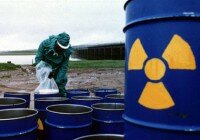Draft EU radioactive waste directive
Posted in Policy on 11/18/2010 02:12 pm by Stephen Tindale The European Commission has now published a draft directive on safety standards for the disposal of high-level radioactive waste from nuclear power plants and research facilities. Part of the Commission’s aim is to build public confidence in nuclear power – in 2009 the EU adopted rules on the safety of operating power plants and on-site storage. Opponents often cite waste as the key issue that leads them to reject nuclear power and recent events in Germany have again demonstrated that nuclear waste has the potential to provoke serious protest. So it is good news that the Commission is addressing the issue. However, the draft directive is not particularly strong, not very ambitious and wrong to promote deep disposal as its preferred waste management option.
The European Commission has now published a draft directive on safety standards for the disposal of high-level radioactive waste from nuclear power plants and research facilities. Part of the Commission’s aim is to build public confidence in nuclear power – in 2009 the EU adopted rules on the safety of operating power plants and on-site storage. Opponents often cite waste as the key issue that leads them to reject nuclear power and recent events in Germany have again demonstrated that nuclear waste has the potential to provoke serious protest. So it is good news that the Commission is addressing the issue. However, the draft directive is not particularly strong, not very ambitious and wrong to promote deep disposal as its preferred waste management option.
The best aspect of the draft is that it proposes binding standards waste disposal, based on standards developed by the IAEA. This will not satisfy opponents – the IAEA is, after all, part of the ‘nuclear cabal’ – but it is sensible to have binding standards overseen by international organisations. In several member-states, there is greater public confidence in the administrative ability of the Commission than in the national government.
Another good aspect is the proposal to ban on the export of nuclear waste to countries outside the EU (although those eastern European countries which export waste to Russia will be allowed to continue to do so, as their accession treaties require).
However, there is no clear timetable for the construction of waste facilities. Sweden, Finland and France are planning to complete facilities between 2020 and 2025. Other member states have no plans yet. The draft directive says that countries would have to draw up national programmes within four years of the Directive’s adoption demonstrating a detailed timeline of their plans for disposal. These programmes would have to specify plans for the construction and management of disposal facilities, timetables for their construction, cost assessments and financing schemes.
The Commission probably did not go further to avoid annoying national governments on ‘subsidiarity’ grounds. National governments would argue that it is up to them, not the Commission, to set a timetable. However, the Commission does risk upsetting member states by recommending deep underground storage as the best way to deal with high-level waste. This is brave of the Commission, but unfortunately it has chosen the wrong option. The key issue is whether the Commission is promoting storage or disposal. Material which remains radioactive for thousands of years cannot be ‘disposed of’. It can, and should be, safely stored, but must also be monitored and should be retrievable if any problems occur. Putting it underground is sensible, as this would increase security and reduce the risk of terrorist attack. However, shallow underground storage would be better than deep underground storage. Shallow would also be considerably cheaper, so making nuclear generation less expensive (though it will never be cheap).
Nuclear waste is a serious issue, but radioactive waste is a less serious problem than carbon dioxide, which should also be regarded as a waste. It is more sensible to keep waste somewhere where it can be managed than to put it up into the atmosphere where we can do nothing about it.


12/04/2010 at 2:40 am
I don’t always agree with you (thank God, that would be boring), but I have to tell you you are a great writer.